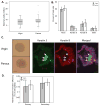Evidence that an early pregnancy causes a persistent decrease in the number of functional mammary epithelial stem cells--implications for pregnancy-induced protection against breast cancer
- PMID: 18787212
- PMCID: PMC2647777
- DOI: 10.1634/stemcells.2008-0103
Evidence that an early pregnancy causes a persistent decrease in the number of functional mammary epithelial stem cells--implications for pregnancy-induced protection against breast cancer
Abstract
A completed pregnancy at a young age reduces a woman's lifetime risk of breast cancer by up to 50%. A similar protective effect of an early pregnancy has been observed in rodent models using chemical carcinogens. However, the mechanisms responsible for this protective effect remain unclear. Stem cells have been proposed to be the cells of origin for breast cancer. We hypothesized that an early pregnancy reduces adult levels of either mammary stem cells or mammary multipotent progenitor cells. Unsorted mammary cells from adult mice that had undergone an early parity had the same mammosphere formation efficiency as cells from age-matched virgin mice. However, when we transplanted adult mammary cells in limiting dilutions into cleared fat pads of syngeneic mice, we found a significant reduction in the outgrowth potential of the cells from early parous mice compared with age-matched virgin mice. The extent of fat pad filling in successful outgrowths did not change, suggesting that although mammary stem cells in parous mice retained their functional competence, the number of mammary stem cells was reduced. Our results provide the first direct evidence that an early pregnancy has an effect on mammary stem cells.
Conflict of interest statement
The authors declare no conflicts of interest
Figures


Comment in
-
Re: "Evidence that an early pregnancy causes a persistent decrease in the number of functional mammary epithelial stem cells-implications for pregnancy-induced protection against breast cancer" by Siwko et al.Stem Cells. 2009 May;27(5):1223; author reply 1224-5. doi: 10.1002/stem.19. Stem Cells. 2009. PMID: 19418459 No abstract available.
References
-
- Henderson BE, Powell D, Rosario I, et al. An epidemiologic study of breast cancer. J Natl Cancer Inst. 1974;53:609–614. - PubMed
-
- Trichopoulos D, Hsieh CC, MacMahon B, et al. Age at any birth and breast cancer risk. Int J Cancer. 1983;31:701–704. - PubMed
-
- Nichols HB, Trentham-Dietz A, Love RR, et al. Differences in breast cancer risk factors by tumor marker subtypes among premenopausal Vietnamese and Chinese women. Cancer Epidemiol Biomarkers Prev. 2005;14:41–47. - PubMed
Publication types
MeSH terms
Substances
Grants and funding
LinkOut - more resources
Full Text Sources
Medical

